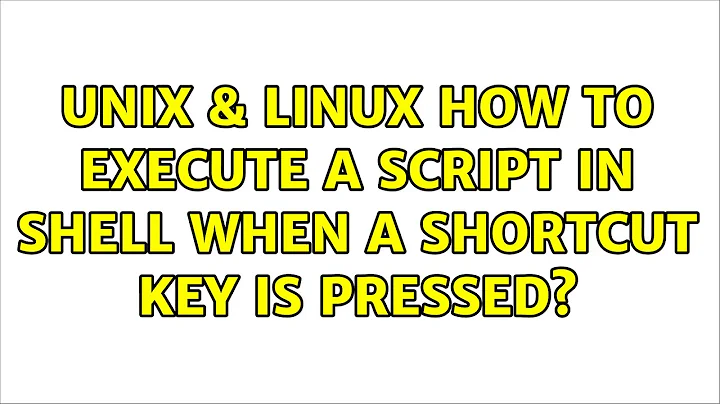How to execute a script in shell when a shortcut key is pressed
You can use the builtin command, bind to map a keyboard shortcut so that it executes a command/shell script.
Example
Say we want to run the command, pwd, when we press the F12 key.
$ bind '"\e[24~":"pwd\n"'
Now when I press F12 at my prompt, $:
$ pwd
/home/saml
Determining keyboard shortcuts
You can use the following technique to determine the escape code for a given keyboard shortcut. On most systems press Ctrl + V, release, and then press the key you want the code for. There are some other systems it will work with M instead of V
Example
Pressing Ctrl + V then release both Ctrl and V and finally press F12 in a terminal window returns this:
$ ^[[24~
This output can be interpreted as follows, ^[ is the Esc key. So when we want to specify this particular key using the bind command we need to use a \e to denote the Esc key followed by everything else from above. So the bind command looks like this:
$ bind '"\e[24~":"....."'
Executing a command in the middle
You can also make use of bind -x to setup keyboard shortcuts that will run commands while you're in the middle of typing something at the prompt, and these commands' output will be displayed, but what ever you were typing at the prompt will remain intact.
$ bind -x '"\eW":"..."'
NOTE: This method only works with keyboard shortcuts that output 1 character, so F12 won't work here.
Example
Let's alias the keyboard shortcut Alt + Shift + W.
$ bind -x '"\eW":"who"'
Say I'm typing the command finger:
$ finger
Now I hit the keyboard shortcut Alt + Shift + W:
saml tty1 2013-09-01 11:01 (:0)
saml pts/0 2013-09-01 11:03 (:0.0)
saml pts/1 2013-09-01 11:05 (:0.0)
saml pts/2 2013-09-01 11:05 (:0.0)
saml pts/5 2013-09-03 22:45 (:0.0)
$ finger
What's going on is bind is running the command defined, who, taking its output and inserting it in front of the prompt. If you repeat it you'll see what's going on, here's output from me hitting it 2 times:
saml tty1 2013-09-01 11:01 (:0)
saml pts/0 2013-09-01 11:03 (:0.0)
saml pts/1 2013-09-01 11:05 (:0.0)
saml pts/2 2013-09-01 11:05 (:0.0)
saml pts/5 2013-09-03 22:45 (:0.0)
saml tty1 2013-09-01 11:01 (:0)
saml pts/0 2013-09-01 11:03 (:0.0)
saml pts/1 2013-09-01 11:05 (:0.0)
saml pts/2 2013-09-01 11:05 (:0.0)
saml pts/5 2013-09-03 22:45 (:0.0)
$ finger
Your problem
So one idea would be to use the bind -x method above and cat to display this text file at your prompt:
$ bind -x '"\eW":"cat someinfo.txt"'
Now when I run commands I can see this file like so:
This is text from some
multi-line file reminding
me how to do some
stuff
$ finger
The output of file someinfo.txt is being displayed above my finger command above.
References
Related videos on Youtube
user3539
Updated on September 18, 2022Comments
-
user3539 over 1 year
How could I execute a script in Shell when a shortcut key is pressed.
Essentially what I need is when a shortcut key is pressed the script should read from a file and display that content in the terminal.
-
 Admin over 9 yearsI tried the method you used
Admin over 9 yearsI tried the method you usedbind '"\e[24~":"airmon-ng start wlan0\n"'but after I closed the terminal, the thing seems to be reset and all the hotkeys are gone
-
-
Lars Rohrbach over 10 yearsSo bind to a script that displays the contents.
-
 aliteralmind over 9 yearsCtrl+m is not working for me. It acts as if I just pressed enter. An alternative I think (I'm a bash newbie) is to type
aliteralmind over 9 yearsCtrl+m is not working for me. It acts as if I just pressed enter. An alternative I think (I'm a bash newbie) is to typeecho '(space after the single-quote), then press Ctrl+v, then the key you want, and then space, single-quote...as described here. Example:echo ' ^[OD ' -
 alper almost 4 yearsCan I apply these by using
alper almost 4 yearsCan I apply these by usingbindkey?

![Write Your Own Bash Scripts for Automation [Tutorial]](https://i.ytimg.com/vi/PPQ8m8xQAs8/hq720.jpg?sqp=-oaymwEcCNAFEJQDSFXyq4qpAw4IARUAAIhCGAFwAcABBg==&rs=AOn4CLCwQaGsEd2aIIwg4kHP-QI1pGNjCg)

![How to Fix “Running Scripts Is Disabled on This System” in Powershell on Windows 10 [Tutorial]](https://i.ytimg.com/vi/F-fWwkG5Xrk/hq720.jpg?sqp=-oaymwEcCNAFEJQDSFXyq4qpAw4IARUAAIhCGAFwAcABBg==&rs=AOn4CLAKhhfyvMF-34sRI0y-wZ4Pen5bgg)
